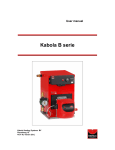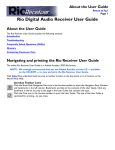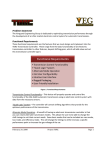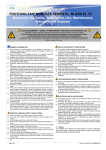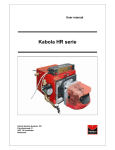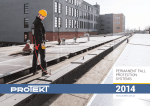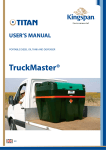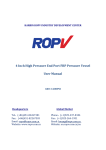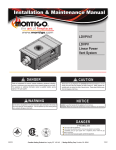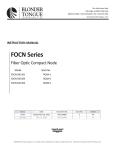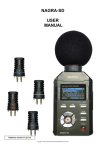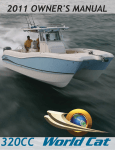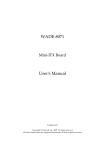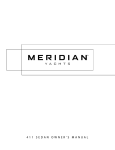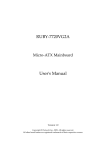Download Kabola - Equipment
Transcript
Preface This user-manual is written to enable the safe operation of the B-series central heating boilers with integrated calorifier control. The user must read this manual before installation of the boiler and must follow the instructions within this manual. Therefore, this manual must be kept with the boiler. In chapter 2, the safety instructions are detailed, which have to be complied with when installing and using the boiler. In othe chapters you will fiind safety instructions, that can be identified in the following way. Hint: This gives the user suggestions and advise to facilitate the executioon of certain tasks. Attention: Additional information is supplied to the user, and possible problems are indicated. Warning: Watch out for possible (life-threatening) injuries. For any remarks, wishes or omissions you can contact your supplier of Kabola Heating Systems. We also welcome any remarks to improve this manual. We wish you a lot of pleasure from your purchase. Kabola Heating Systems Populierenweg 41 NL 3421 TX Oudewater The Netherlands Tel: +31(0)348-561277 Fax: +31(0)348-562484 Site: www.kabola.nl E-mail: [email protected] © 2005 Kabola Heating Systems Copying of (parts of) this manual, is only allowed with written consent Kabola Heating Systems. User manual B–boiler series 2 Table of contents Preface Table of contents 1 Introduction 1.1 General 1.2 Range of application 1.3 Product description 1.4 Technical specifications 2 Safety 2.1 General safety 2.2 Safety instructions 3 Transport and storage 3.1 Transport 3.2 Storage 4 Installing and preparing for first use 4.1 Installation 4.1.1 Fitting the boiler 4.1.2 Connection to the central heating system 4.1.3 Connection of domestic hot water supply 4.1.4 Flue gas outlet 4.1.5 Electrical connection 4.1.6 Filling the central heating system 4.1.7 Mounting the oil burner 4.1.8 Connecting the oil filter and oil burner 4.2 Starting your system 5 Operating the boiler 5.1 Explanation of the dashboard 5.2 Operation of the frost guard 5.3 Function of the domestic hot water supply 6 Cleaning and maintenance 6.1 Points for attention 6.2 Cleaning and maintenance 7 End of life of the boiler Appendix Appendix A Technical specifications Appendix B Spare parts Appendix C Electrical diagram 230 V Appendix D Electrical diagram 24 V Appendix E Troubleshooting Appendix F CE declaration 2 3 4 4 4 4 4 5 5 5 6 6 6 6 6 6 7 7 7 9 10 11 12 12 13 13 14 14 14 14 14 15 16 17 18 19 20 21 22 User manual B–boiler series 3 1 Introduction 1.1 General Congatulations with your purchase of this Kabola boiler. This user-manual covers the B-series with intgrated calorifier control. The B-series with integrated calorifier control cover a wide range of boilers with a broad range of applications. By purchasing this boiler, you have acquired a product, which is of high quality through the application of the latest European standards and directives. 1.2 Range of application The B-series boilers with integrated calorifier control are designed to generate heat for the heating of water for a central heating system. By means of the integrated calorifier control the boilers can also be used for the generation of domestic hot water through an external calorifier. This calorifier is not included in the standard boiler set. The dimensions of the rooms to be heated, have to be taken into consideration. These boilers are not designed for direct heating of the rooms in which they are installed. 1.3 Product description The boilers of the B-calorifier series heat the boiler water by means of a pressure jet burner which is installed on front of the boiler. The boilers are available in both 230 VAC and 24 VDC versions. The 230 VAC model requires a small 24 VDC power supply for control purposes. All B-calorifier series boilers work in the same way, they only differ in the dimensions and the capacities of the boilers (see also technical specifications in Appendix A) For fuel, diesel oil has to be used. 1.4 Technical specifications The most important technical specifications are listed on the plate on the front of the boiler. More technical details are listed in Appendix A. User manual B–boiler series 4 2 Safety In this chapter we emphasise the safety-related points for operating the boiler. 2.1 General safety Warning: Although Kabola Heating Systems designs and producees its products according to the current safaty standards, it is possible that dangers may present themselves, which could lead to injuries or damage to the boiler, if the safety instructions in this manual are not complied with. The user must: • Have read and understood the chapter "safety"; • Avoid any actions which may lead to dangers to his health or others; • Avoid any actions which may lead to damage to the boiler; • Ensure that the boiler is only used when the boiler is in sound technical condition; • Ensure that the safety regulations are observed whilst operating the boiler. Attention: No alterations to the boilers may be done, without the explicit written consent of Kabola Heating Systems! 2.2 Safety instructions In this chapter we emphasise the safety-related points for operating the boiler. MEASURES FOR A SAFE INSTALLATION • Don't store any flammable and/or gaseous products in the room where the boiler is installed to avoid explosions and fires. • Install the boiler iin a non-humid environment on a firm horizontal base. • Ensure that there is sufficient ventilation in the room where the boiler is installed (See also § 4.1.1). • Make sure, before you start connecting the boiler, that the system is disconnected from the power supply. • Only use multi-stranded wire for electrical connections. • Do not change the + pole with the – pole of the battery (for the 24 Volt DC power supply) MEASURES FOR A SAFE OPERATION • • • • • • Never change the settings of the burner. Don't use any aggressive solvents which may affect the boiler (like petrol or turpentine). Insulate the chimney, when it can be touched by body parts. Don't damage the fire bricks. Make sure that the boiler and burner are checked annually by a skilled expert. Make sure that before you start any work on the boiler that the system is disconnected form the power supply. • Make sure that any surplus oil is collected in case of oil spillage. • We advise you to have any maintenance or repairs carried out by skilled experts. User manual B–boiler series 5 3 Transport and storage 3.1 Transport Take following precautions before transporting the boiler: • Drain the water from the boiler; • Uncouple the fuel system; • Remove the burner (see § 4.1.5, replacing the burner). While transporting the boiler take following precautions: • Don't damage the boiler, use a blanket to cover the boiler; • Transport the boiler standing up, is this not possible transport the boiler lying down on its back; • For the boiler models B-25 onwards use the hoisting eye to move the boiler. This hoisting eye is located below the top of the boiler cover. 3.2 Storage Take the following precautions when the boiler is stored for a longer period of time: • Store the boiler and accompanying parts in a dry place; • Dismount the burner (see § 4.1.5) • Store the boiler standing up; • Store the boiler on a firm horizontal base. 4 Installing and preparing for first use In this chapter you will find directions and hints for a correct placement and fitting of the boiler and accompanying parts. Warning: Do not storee any flammable or gaseous substances in the room where the boiler installed. This is to ensure that no explosions or fires can occur. 4.1 Installation 4.1.1 Fitting the boiler • Install the boiler in a dry place. • Install the boiler on a firm horizontal base. • Make sure there is sufficient supply of fresh air in the room where the boiler is installed (see hint below). Hint: As a rule of thumb for the ventilation openings, take 2,5 times the diameter of the flue gas outlet. Figure 1 • To avoid movement secure the base of the boiler by means of spotwelds or with nuts and bolts.. • Keep a minimum distance of 250 mm behind the boiler for the flue-gas outlet (see figure 1). • Use an earthed plug socket for connecting the 230 Volt AC versions to the power supply. User manual B–boiler series 6 4.1.2 Connection to the central heating system PIPING Take note of the following points, when installing the piping: • Install the piping in such a way, that the boiler (cover and dashboard) remains accessible; • Provide enough bleeding points in places where air may collect, especially near the boiler. Attention: Install a bleeding point near the boiler, especially when the piping does not go up. Connect the piping to the boiler as follows (see figure 2): 1. Install the feed to the CH at outlet B of the 3-way valve; 2. Install the return of the CH on the circulation pump Hint: You may install a shunt with pressure equaliser, when thermostatic radiator valved are applied. Attention: The couplings in the 3-way valve are not sealed at the factory. Make sure that the couplings are sealed, preferably with hemp and fitters kit, when the system is installed. Figure 2 4.1.3 Connection of domestic hot water supply Connect the domestic water supply as follows (figure 2): 1. Install the hot water feed to the calorifier to outlet A of the 3-way valve; 2. Install the return from the calorifier on the return of the CH-circuit using a T-connection. 3. Connect the calorifier thermostat according to 4.1.5. DESCRIPTION OF THE DOMESTIC HOT WATER SUPPLY When the calorifier drops below its set temperature, the boiler will switch on the heat up the calorifier. The calorifier has preference over the central heating. When the calorifier is heated, the boiler will be run at 90°C, whatever the setting of the boiler thermostat is. Once the calorifier has reached the required temperature, the boiler will continue to heat the calorifier for another 3 minutes. When the after purge time is finished, the rest of the heat will be dumped in the CH-circuit. The time for the heat dump is set by the pump timer on the dashboard. Attention: The calorifier thermostat must be set to 70°C. 4.1.4 Flue gas outlet GENERAL The flue gas outlet is an essential part of your heating installation. An incorrect flue gas outlet reduces the lifespan of your boiler considerably and has a negative impact on the efficiency. Remember when installing the flue, that even the best boiler won't work properly unless the flue is properly installed. Warning: Because the flue gas temperature lies between 180-240°C, it is advisable to insulate the flue with heat-resistant material on those parts where contact with human body parts is possible. For a correct flue gas outlet the following points need to be observed: • Use the proper diameter, use a diameter equal to the diameter of the flue gas outlet on the boiler (see also technical specification). • Use double-walled chimney pipe outside to prevent a rapid cooling of the dlue gasses, which may result in condensation in the chimney. User manual B–boiler series 7 Hint: When using an existing chimney of a larger diameter than the diameter on the boiler, you can install flexible piping of the correct diameter insides the existing chimney. The flue can be installed in several different ways. You must carefully coonsider under which circumstances the boiler will be used. For sea going boats and sail boats we advise the installation of a vertical fllue where the heel angles of the boat may be larger. The following installationn examples are most common. − HORIZONTAL FLUE GAS OUTLET It is possible to fit a horizontal flue gas outlet to the boiler. The following points need to be observed: − The maximum allowed length Figure 3 is 5 metres. − Make sure that the outlet is positioned at a sufficient height above the waterline. If this is not possible use a swan neck bend in the pipe as in figure 3. − Use the correct hull fittings for installing the flue through a hullside − Don''t use more than 5 elbows of 90°. − Every elbow of 90° is equivalent to 1 metre straight pipe − When a 80x60 silencer is installed, only the last meter of the chimney may be installed using 60 mm pipe − VERTICAL FLUE GAS OUTLET This way if installation is preferable for seagoing boats and sailing boats, because these boats encounter large angles of heel through waves and under sail. For this kind of flue gas outlet, the following points are important: − Install a proper storm cowl oon top of the chimney (thismust stop rain from entering) (figure 3). − Install deck fittings for installing the flue through a deck. − Install a water trap (figure 4), to trap possible water caused by condensation − Keep the chimney as vertical as possible. − Don't use more than 5 elbows 90°. − The maximum allowed lenght is 10 metres. − Every elbow of 90° counts as 1 metre. − Use outside double walled chimney pipe Hint: To reduce the noise from flames, it is wise to install a silencer in the flue Your Kabola supplier can provide you with all components which may be required for installation such as: − Cowls; − Flexible piping; − Single and double walled chimney pipes; − Hull and deck fittings; − Silencers; − Water traps; − Insulation. User manual B–boiler series Figure 4 8 4.1.5 Electrical connection Warning: Disconnect the power supply from the boiler before you start the installation. The quality of 230 VAC power supply to the boiler should be as good as the power supply from a land line. ELECTRICAL CONNECTION The supplied room thermostat should be installed as listed below: − Connecting the room thermostat (see figure 5 and electrical diagram in Appendix C) 1. Remove the cover of the main connector situated below the dashboard; 2. Remove, if present, the wire between point 1 and 2; 3. Connect point 1 of the connector to point L of the room thermostat; 4. Connect point 2 of the connector ro point L1 of the room thermostat; Attention: Figure 5 The core diameter of the connections mentioned above must be 0,75 mm² maximum. The wires should be suitable for the voltage used. − Connection of the frost guard 1. Connect the switch to points 3 and 4 of the main connector. (Operation of the frost guard is explained in chapter 5) - Connection of the calorifier thermostat Connect the calorifier thermostat to the dedicated connections (see Appendix C) - Electrical installatioon 24 VDC poweer supply for 230 VAC version Warning: Never change the + pole with the - pole on the battery (see figure 5). 1. Connect point 5 of the main connector to the + pole of the battery. 2. Connect point 6 of the main connector to the - pole of the battery. 3. Replace the cover on the main connector. When no 24 VDC power supply is available, an adapter 230 x 24 Volt may be used (Ordernr 9-I051). When a 12 VDC power supply is available a DC-converter 12 V in 24 V out may be used (Ordernr 15P001). The wire diameter for the supply mentioned above has to be 1 mm² for the 230 VAC version. Attention: The calorifier and room thermostat both switch 24 VDC. User manual B–boiler series 9 - Electrical installation 24 VDC power supply for 24 VDC version Warning: Never change the+ pole with the – pole on the battery (see figure 5). 1. Connect point 5 of the main connector to the + pole of the battery. 2. Connect point 6 of the main connector to the - pole of the battery. 3. Replace the cover of the main connector. The core diameter of the wires form points 5 and 6 of the main connector have to comply with the values from the table below. Table 1 Distance to the battery ± 6 metres ± 10 metres ± 20 metres Core diameter 6 mm² 10 mm² 16 mm² 4.1.6 Filling the central heating system The pressure in the system should: • Never be lower than 0,5 bar cold; • Never be higher than 2,5 bar hot. Follow the procedure below for filling the CH-system (see figure 6): 1. Switch off the boiler; 2. Turn nut (1) loose; 3. Install the hose connection on the opening; 4. Connect the hose with a hose clamp to the connection and slowly open the valve (2); 5. Fill the system slowly with water, until the pressure indicator indicates a pressure of 2 bar; 6. Close the valve (2); 7. Bleed the CH-system; 8. If necessary, fill with water again up to 2 bar of pressure; 9. Switch on the boiler and let the pump run for about 5 minutes; 10. Switch off the boiler; 11. Check the water pressure, if it is too low, repeat steps 5 through 10; 12. Remove the hose. Figure 6 Hint: The CH-system can be filled with cooling fluid, suited for CH-systems (pH-value 8.5) worden gevuld. BLEEDING THE CIRCULATION PUMP The circulation pump can only be bled when the electrical circuit is connected, because this has to be done with a running pump Follow the points listed below to bleed the pump (see figure 7): 1. Check if the rotor can rotate without problems by turning the pump by hand (see manual pump); 2. Loosen the screw on front of the pump 1/2 to 1 turn with a screwdriver; 3. Fasten the srew when water comes out of the opening; 4. The pump is bled. Figure 7 User manual B–boiler series 10 Attention: When locking pump couplings are supplief with the boiler, the adjusting grooves must point towards the pump. 4.1.7 Mounting the oil burner Hint: Check if the inspection opening on the mounting plate can be reached. If this is not the case the mounting plate can be turned 180° to reach the opening easier. For a B12 you need to saw an extra piece off the flance. The mounting of the burner is done in the following way: 1. Place the nut for the flange bolt in the dedicated position, screw the bolt into the nut and place the gasket; 2. Mount the flange with 4 supplied M*-bolts and hand tighten these on the mounting plate. The arrow on the flange should point upward. Hint: Smear some sealant in the crack in the flange to seal. 3. 3.1. Measure and set the distance from the back of the gasket mounted behind the mounting plate, to the front of the flange using the table below and figure 8; Boiler type B12-B17 B25-B35-B45 Distance in mm 60 155 3.2. Scribe the distance on the burner; 3.3. Push the flame tube gently in place up to the scribed position (see figure 8). Figure 8 4. Lift de burner a little according to 7A (figure 9); 5. Fasten bolt 7 (Figure 9) on the flange to clamp the burner; 6. The bolts which have been hand tigthened should now be fastened using a spanner. Attention: Take care that the flame tube is not damaged during installation. Repairs to the flame tube are very expensive and don't fall under warranty. User manual B–boiler series 11 4.1.8 Connecting the oil filter and oil burner To connect the filter to the burner follow the procedure below (see also figure 9): Figure 9 1. Remove the burner cover (1); 2. Connect the oil pump (2) to the oil filter (3), using the included fuel hoses. Make sure that the flow directions on the pump comply with those on the filter; 3. Connect the fuel line from the tank to the filter (5A). The fuel line must have an outer diameter of 8 mm and must be made from copper or steel. The fuel line has to be connected directly to the oil tank. Correct functioning of the burner can not be guaranteed when a fuel manifol or T connection is installed; 4. Connect the plug (4) from the boiler to the burner. Hint: When the oil tank is situated below the boiler or when the oil supply line comes from below the boiler, it is advisable to use a self bleeding oil filter. This prevents unnecessary malfunctioning of the burner. In the manual of the burner you will find an overview with the allowed dimensions of the oil supply line. 4.2 Starting your system When everything is connected follow the procedure below: 1. Connect the boiler to the power supply, Both the 230 VAC and the 24 VDC will need to be connected for the 230 VAC version and only the 24 VDC for the 24 VDC version. 2. Switch the boiler on with the on/off switch on the dashboard. The lamp in the switch will indicate that the system is active. This lamp is not present in the 24 VDC version. The LED on the top left of the dashboard should be lighted for both versions. 3. Set the required boiler temperature between 55 and 90°C using the boiler thermostat. 4. Set the room thermostat so that it is switched on (see manual of the room thermostat) 5. Starting of the oilburner (see figure 9): 5.1. Open the valve in fuel line (5); 5.2. Install the bleed hose (3C) on the bleed opening of the oil filter; User manual B–boiler series 12 5.3. Open the valve on the oil filter (5A); 5.4. Start the oil burner; 5.5. The burner switches on, this wull take approximately 1,5 minutes because of the oil preheating element; 5.6. Open the bleed valve on the oil filter (3B); 5.7. Check if oil is coming out of the hose(3C); 5.8. Check all oil connections for leaks; 5.8.1. If the burner does not start, the control light (8) will light; 5.8.2. Close the bleed valve (3B) on the oil filter; 5.8.3. Wait approximately 3 minutes; 5.8.4. Reset the burner by pushing button (8) and return to 5.4 (repeat if necessary). 5.9. Close the bleed valve(3B) when only oil and no bubbles come out of the hose; Attention: The oil burner is tested by the manufacturer, not adjusted. The adjustment of the burner has to be done by an experienced installer, because this requires expert knowledge. To be eligible for warranty, the boiler has to be adjusted by an approved installer. Contact your Kabola supplier to make an appointment. Never adjust the burner using your own initiative. 5 Operating the boiler When the boiler has been started and adjusted according to 4.2, operation fo the boiler is very simple. 1. The required temperature is set using the lower knob 8 (figure 10). 2. The after purge cycle of the circulation pump is set with the upper knob 7 (figure 10). This cycle can be set from 3 to 10 minutes. The required temperature is set with the room thermostat, which controls the boiler. The calorifier thermostat controls the 3-way valve on the boiler. The operation of the room thermostat is explained in the manual of the room thermostat. If problems arise with the operation of the boiler, you will find a list of possible problems and solutions in Appendix D. 5.1 Explanation of the dashboard The LED’s on the dashboard display the active functions of the boiler 1. This LED indicates if the control panel is connected to the 24 VDC power supply. 2. This LED indicates if the room thermostat is switched on. 3. This LED indicates if the frost guard is active. 4. This LED if the burner is active. 5. This LED indicates if the circulation pump is active. 6. This LED indicates if the 3-way valve is active, this indicates that the calorifier is heated. Figure 10 User manual B–boiler series 13 5.2 Operation of the frost guard The switch which is mounted on the room thermostat is used when you leave the boat and wish to switch off the central heating system. The central heating system will then only switch on when the ambient temperature falls + 5°C. To activate the frost guard follow the procedure below (figure 11) 1. Switch the frost guard switch (1) on the side of the room thermostat to the off-position (up); 2. LED 3 on the dashboard is ligthing. If you only want to use the domestic water supply, follow the procedure below: 1. Switch the frost guard switch on the side (1) of the thermostat to the on-position (down); 2. LED 3 on the dashboard is now off. 5.3 Function of the domestic hot water supply When the calorifier drops below the set temperature, the boiler will switch on to heat the calorifier. The calorifier has priority over the central heating. When the calorifier is heated the boiler will be run at 90°C, independent of the set boiler temperature. Has the calorifier reached its set temperature, the pump will continue to run for 3 minutes to provide heat to the calorifier, after which the rest heat will be diverted to the central heating circuit. Using the pump timer you can determine, how long the pump will keep pumping water through the central heating. Attention: The calorifier thermostat must be set to 70°C. 6 Cleaning and maintenance 6.1 Points for attention Spare parts must be ordered through your Kabola supplier. For warranty purposes only original spare parts must be used. When ordering spare parts, state the type of boiler and its serial number. Your Kabola supplier will then be able to supply the correct parts. In Appendix B, the main spare parts are listed. 6.2 Cleaning and maintenance Warning: Maintenance and repairs should only take place when the boiler is switched ff, this is because the boiler may start unexpectedly. Take the plug form the wall socket for the 230 VAC versions. Disconnect the power supply for the 24 VDC version. Warning: Maintenance and reppairs may only be performed by personnel, who have read and understood the information in this manual, preferably an expert installer or mechanic Every week • Drain the water from the water trap if installed User manual B–boiler series 14 Every year 1. Clean the boiler; 1.1. Remove the burner (see § 4.1.7); 1.2. Remove the burner mounting plate from the boiler; 1.3. Remove the top cover, be careful not to damge the earthing wire for the 230 VAC version; 1.4. Remove the top insulation; 1.5. Remove the 4 bolts on the boiler top; 1.6. Remove the boiler top; Hint: With a B-8 boiler you can remove the upper fire brick to facilitate the cleaning of the heat exchanger. When replacing the fire brick you have to be careful to fit the fire brick to the back of boiler.. 1.7. Clean the inside of the boiler, using a stiff brush; 1.8. Clean the space between the heat exchanger with a thin metal strip Attention: 2. 3. 4. 5. Do not use any aggressive solvents like thinner or gasoline. 1.9. Clean the boiler with a vacuum cleaner; 1.10. Replace the boiler top, if necessary use a new gasket; 1.11. Replace the 4 bolts and fasten these; 1.12. Replace the insulation; 1.13. Replace the top cover of the boiler, make sure the earthing wire is fitted correctly; 1.14. Replace the burner mounting plate and remount the burner (see § 4.1.5). Clean the chimney; Clean the watertrap if installed; Change the oil filter element Clean the burner (see manual of the burner) Hint: Kabola Heating Systems has a standard set of replacement parts for the yearly maintenance (see Appendix B). Attention: The old oil filter element has to be processed as chemical waste. 7 End of life of the boiler When the boiler is scrapped, take note of the points listed below: • Process the oil filter and the oil hose as chemical waste; • Separate the metal from the plastic parts and dispose off them separately. • Process any excess oil in an environmentally freindly way. • Transport the boiler according to the instructions in chapter 3 • Recycle this manual. User manual B–boiler series 15 Appendix User manual B–boiler series 16 Appendix A Technical specifications Type A B C D E F G H I J Chimney ø Flue gas temp °C C.H.-connection IP-value Burner 230 V 24 V Nozzle 60° Nom. Capacity kW min max Max oil consumption kg/h Test pressure in bar Working pressure in bar Weight Water volume Control range temperature Insulation thickness in mm Fuel Efficiency in % Waterside efficiency % Relative standby loss B-8 B-12 B-17 505 343 356 235 320 70 310 336 400 80 80 170-190 1” 600 347 115 361 243 343 70 325 361 480 80 80 180-240 1” 670 411 115 416 364 408 70 325 416 548 80 80 180-240 1” 2-B009 3-C012 0.40 8.0 11.0 1.2 5 3 50 20 65-90 30 2-B010 3-C013 0.40 11.2 14 1.4 5 3 65 30 65-90 30 97 94 91 88 User manual B–boiler series B-25 970 455 115 466 283 388 70 385 396 753 100 100 180-220 5/4” 50-11 2-B011 2-B012 3-C014 3-C015 0.50 0.75 14 19.7 19.7 29 1.9 3.3 5 5 3 3 94 118 36 47 65-90 65-90 30 50 HBO 1, HBO 2, diesel of gasolie 91 92 88 89 3% B-35 B-45 970 455 115 468 284 491 70 385 503 754 130 125 180-230 5/4” 970 445 125 488 284 580 70 385 593 754 150 150 180-230 1½” 2-B013 3-C016 1.00 29 40.7 3.7 5 3 140 64 65-90 50 2-B014 3-C017 1.25 40.7 52.3 5.2 5 3 155 98 65-90 50 92 90 92 90 17 Appendix B Spare parts Listed below you will find the most important parts for the boilers. These parts can be ordered from your Kabola supplier, please state type and serial number. The numbers refer to the image. 1 Boiler top cover 2 Insulation 3 4 5 6 7 8 9 10 Boiler cover Boiler gasker Maximum thermostat 3-way valve Dashboard NTC-probe Control PCB On/Off switch 11 12 13 14 Pump coupling Circulation pump Seal 5/4" Elbow 15 Pressure valve/ pressure gauge fill/drain cock 16 Main connector 17 Fire inspection opening 18 Oil burner 19 Burner mounting plate 20 Gasket burner mounting plate 21 Boiler cover side/front 22 Boiler cover back 23 Oil filter (not shown in picture) 24 Room thermostat (not shown in picture) Mineral wool thickness Appendix A For B8 a plate 24 VAC! KBC specification No light in 24 VDC version Two Dependent on type (1x1", 5/4x1" or 1½x1") Wavicom See specification max. 25µm, Pmax 6 bar max. capacity 200 l/h, total ± 6000 l. max. vacuum -0,5 bar L&G REV 11 The following spare parts are available. 25 Nozzle See technical specifications For the yearly maintenance Kabola Heating Systems have compiled a set of spare parts often used during maintenance. 26 Service set consisting of 4+23+25 User manual B–boiler series 18 Appendix C Electrical diagram 230 V User manual B–boiler series 19 Appendix D Electrical diagram 24 V User manual B–boiler series 20 Appendix E Troubleshooting Listed below you will find a list with possible problems, their reasons and solutions. When you encounter problems not listed, you should contact your dealer. Never try to solve problems on your own. Problem Burner will not start Possible reason Oil supply interrupted Power supply interrupted Burner stops Burner starts pulsing Flame protection dirty (photo cell) Flame protection defect (photo cell) Flue gas flow interrupted Boiler dirty Oil supply interrupted Nozzle defective Burner shows error Boiler does not react to thermostat Water is not circulating Low voltage Oil supply interrupted Wire in main connector has not been removed (room thermostat) Boiler thermostat incorrectly adjusted Battery of room thermostat flat Pump couplings are closed Pump not connected to electricity supply Rotor of pump is stuck Possible solution Bleed the oil filter Change contaminated filter element Fill the oil tank Check the fuses Check the power supply Reset burner (once) Clean glass of flame protection Replace flame protection Clear chimney opening Clean boiler See above Replace nozzle Reset burner (once) Check voltage level See above Remove wire from main connector between 1 and 2 Adjust boiler thermostat Replace battery Open pump couplings Connect pump Turn pump with your hand (see pump manual) The LED’s on the dashboard can display the following error codes LED Voltage (1) Fast flashing Slowly flashing Slowly flashing Out 3-way valve (6) Out Out Slowly flashing Flashing Reason Voltage too high Voltage too low Probe incorrectly installed or defect Current too high 3-way valve motor defective The boiler will reset automatically when the problem has disappeared. Action from the user is only required when the NTC-probe is incorrectly installed, the user needs to have the connection of the NTC-probe checked. User manual B–boiler series 21 Appendix F CE declaration User manual B–boiler series 22























